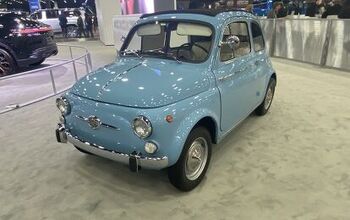Where Have All The Clinton Era Cars Gone?
That moment you realize the oldest car in the parking lot is yours.
Yeah, I just had that moment.
The car in question is a 2001 Honda Accord EX. Four-door. Five-speed. A dodo bird of a used car stuck in today’s finance driven market. I walked around the parking lot you see above trying to find one vehicle, any vehicle, that’s as old as mine.
The blue ’05-ish Caravan on the bottom left came a bit close, but it didn’t happen. Instead, everything else seemed to be on the younger side of the curve, the overwhelming majority of vehicles sold new at a later time in history.
When the hell did my car – the class of 2001 – become the old fart of the village? In this case, the village happened to be Myrtle Beach, South Carolina – a touristy place that regularly displays thousands of trinkets, tchotchkes, and recreational drunks often as old as a Michael Dukakis bumper sticker.
You think I kid? I do! But really, trust me on the trinkets. The same exact souvenirs around during the ’80s and ’90s on the main tourist strip have now relocated to the flea markets and thrift stores. That nice flowery ceramic cup mass produced in Hong Kong back when ‘China’ couldn’t be rubber stamped on cheap Chinese goods is still out there for $1.99 trying to find that one last customer whose name is Alfred or Milly before the flea market finally donates it to Goodwill along with the MC Hammer posters and VHS tapes.
Apparently, older used cars are rapidly approaching the same life cycle when it comes to consumer demand. Everyone is buying new these days – or, at least, new enough. Seven year loans? Nobody did them only a few years ago, but now they’re to our economy what buying stocks on margin were in the ’20s or real estate just a few short years ago. If you can make the note work on paper, you can quickly be given the keys to America’s most fashionable new assets.
It’s a bubble and not the first in our business by a long shot. From Chrysler trying to finance their creaky old K-cars to people they lovingly called PODS (Poor Old Dumb Shits) to Mitsubishi supplementing their ‘zero down, zero interest’ offers to anyone with a pulse and a paycheck, this industry has always been about securitizing and moving the cheap metal. Even if the amortized metal isn’t so old, the wheels of conspicuous consumption have to be greased just right in order to keep that assembly line of wealth flowing – at least until the next bust cycle.
It’s an interesting juxtaposition for a guy who still buys a lot more newer cars these days than older ones. Fourteen years old just isn’t old to me anymore.
Granted, there is no tinworm here in Georgia and the roads are exceptionally smooth, which probably ages the bodies and suspensions of most cars at a rate no more than half the overall northern average. However, the interesting part in most areas of our country is you can drive a 17-year-old Camry or Accord brand new from the late Clinton Era to the present day and not really feel like you missed all that much.
Safety? A bit, though most folks don’t really make it a continuing priority after they’ve bought new unless 1) they have a young family, or 2) they’re shopping for someone else. I find what makes most commuters kick their older cars to the curb is either an expensive repair, maintenance issue or a seemingly incurable emissions problem.
Power? The four-cylinder Accord comfortably did 80 mph for the entire trip and passing power was always there. It doesn’t have as much horsepower as an old Acura NSX, like a 13-year-old Nissan Altima offers at a similar selling price to that 14-year-old Accord. Yet, the lack of power never hurt when it came time to utilize the two- to three-tenths of the performance limits of this vehicle, which is what 90+% of the car driving public already does for the most part.
Fuel economy? Hell no! Over the next five years, for every new car dollar you spend if you’re paying cash, you’re looking at a dime and a nickel in return in lower fuel costs.
In my Accord scenario, I wouldn’t save a single cent in fuel costs if I bought the average new vehicle of today versus keeping that 14-year-old Accord for the next five years. The brakes and timing belt were also recently done, so chances are the next owner will have a good shot at driving it right up to year 20 so long as they take care of the little things before they become big.
And that’s where the problem lies for most folks: the little unpredictable things versus the big long-term expense. Unpredictability, for a common machine that has tens of thousands of parts in varying states of wear, is a greater psychological problem for most car owners than having a $500 payment for years on end.
Most folks simply don’t know much about their cars and manufacturers are increasingly finding ways to capitalize and expand on that lack of knowledge. From adding plastic covers to the top of car engines to removing dipsticks and ease of maintenance opportunities for the aspiring DIY owner, there is a lot of smoke and mirrors done by automakers under the guise of technology.
Additionally, government edicts improving a given vehicle’s performance in some ways add great cost to everyone involved in the design, manufacture, and upkeep of a new car. Long-term goals in improving fuel economy and emissions have always begat new problems for the auto industry and those producing the fuels and oils we use to power our machines.
Just as old CAFE and environmental regulations resulted in billions of repair related expenses back in the ’70s and ’80s, the new regulations of the modern motoring era are pushing technologies with a similar trajectory. Continuously variable transmissions with ‘lifetime fluids’ that increasingly don’t hold up and ever more expensive catalytic converters (and their associated sensors) will likely shorten the time of planned obsolescence.
Sometimes older models really are the better ones, at least when it comes to the real world of car ownership. Am I wrong? Perhaps. But every time I hear an average non-enthusiast bequeathing over $30,000 of their financial earnings to something as financially pointless as a commuter car, I realize that the new car marketplace is just becoming increasingly dependent on the idea of long-term financial dependency for the average car owner.
Will that be a good thing? For anyone? I doubt it if you want to be a car owner. Whatever breakthroughs we achieve through innovation will more than likely be negated by corporate sponsored legislation designed to make the consumer the ultimate bearer of those costs. Whether it’s the brave new world of car sharing helping to eliminate the cyclicality of the auto industry’s boom/bust cycles or the ever declining market segment of DIY owners and long-term keepers who won’t have the money needed to keep their cars on the road, we’re now in an era where long-term financing and perpetual payments have become the new short-term solutions.
And that’s a big problem.
More by Steven Lang
Latest Car Reviews
Read moreLatest Product Reviews
Read moreRecent Comments
- ToolGuy The only way this makes sense to me (still looking) is if it is tied to the realization that they have a capital issue (cash crunch) which is getting in the way of their plans.
- Jeff I do think this is a good thing. Teaching salespeople how to interact with the customer and teaching them some of the features and technical stuff of the vehicles is important.
- MKizzy If Tesla stops maintaining and expanding the Superchargers at current levels, imagine the chaos as more EV owners with high expectations visit crowded and no longer reliable Superchargers.It feels like at this point, Musk is nearly bored enough with Tesla and EVs in general to literally take his ball and going home.
- Incog99 I bought a brand new 4 on the floor 240SX coupe in 1989 in pearl green. I drove it almost 200k miles, put in a killer sound system and never wish I sold it. I graduated to an Infiniti Q45 next and that tank was amazing.
- CanadaCraig As an aside... you are so incredibly vulnerable as you're sitting there WAITING for you EV to charge. It freaks me out.





































Comments
Join the conversation
I still drive my '95 Ford Escort GT. I hit 200k a month ago. I've noticed that location has a lot to do with it here. Where I live in Phoenix, there are plenty of older cars, many from the early 90's. However, when I travel to different areas, that are either newer ares or a bit more affluent, then the age of the cars change too.
One, most of the 15-20 yr old cars are dead. Except here in the Detroit area, where cars seem survive forever. Two, Honda's of that era last forever. I have an 82 Prelude in the garage that still runs. The odometer died around 400000 miles. It is my spare car, an has been loaned to friends, and family when needed. I have an ex whose family Accord has been through half a dozen family members and nearly 500000 miles last I heard. Three, all those cheap lease deals, and easy financing are back, so most anyone can afford a newer car. That cash for clunkers thing about 7 years ago got rid of a lot of them too.